Description: This document describes how to set up load balancing on LANCOM routers that
do not have an integrated DSL modem.
Requirements: You need the current version of LCOS and the current LANtools.
- LCOS as of Version 8 (download)
- LANtools as of Version 8.50 (download)
- A LANCOM router without integrated DSL modem (e.g. a LANCOM 1781EF+)
- One external xDSL modem for each Internet connection. Please refer to the technical specifications of your device to determine the number of Internet connections that your LANCOM router can manage.
Scenario: The configuration is carried out for the following example scenario.
- Two DSL connections are to be load balanced so that they can both be used at the same time.
- The first Internet connection is to be implemented with an external xDSL modem, which is connected to the LANCOM router's WAN port.
- The second Internet connection is to be implemented with an additional external xDSL modem, which is connected to the Ethernet port LAN 1 on the LANCOM router.
- The LANCOM router handles the dial-in and logging on at the provider for both of the DSL connections.
- The LANCOM router is already connected to the local network via Ethernet interface LAN 2.
Information: The LANCOM 1781EF+ enables you to operate up to a maximum of four xDSL connections. For clarity, this example configuration is limited to two DSL lines.
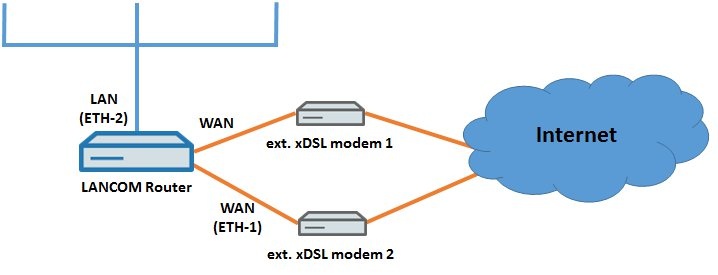 Setting up the first Internet connection:
Setting up the first Internet connection: 1. Launch the Setup Wizard for the LANCOM router and select the option
Set up Internet access.

2. In this example we use the
IPv4 internet protocol.
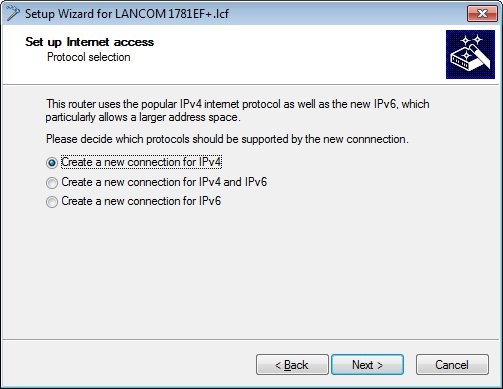
3. Specify that the connection is to be established via the
Ethernet interface.
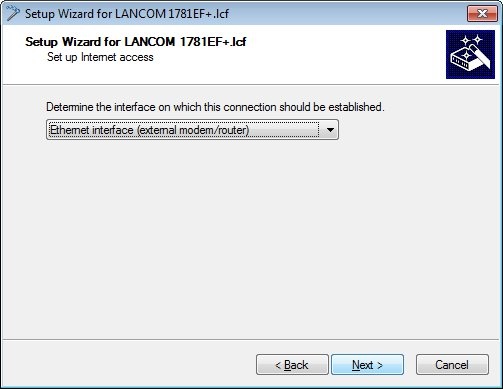
4. As the first external DSL modem is connected to the WAN port of the LANCOM router, the
WAN Ethernet port must be selected in the following dialog.
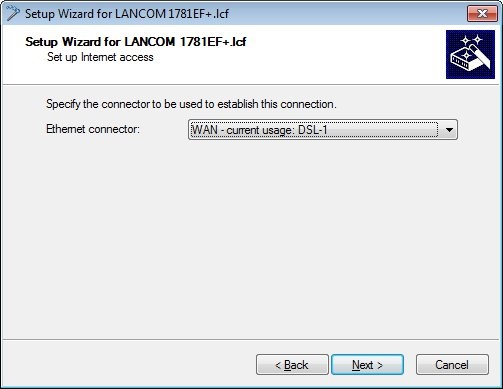
5. Select your
country.
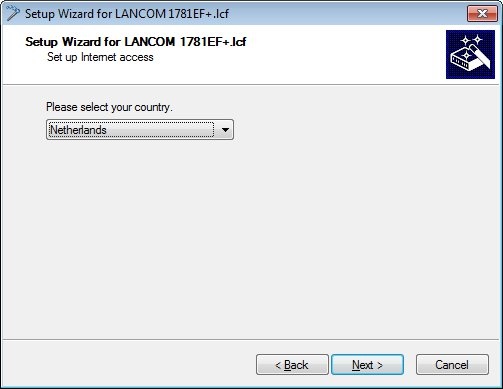
6. Select the option
Internet access via PPP over Ethernet.
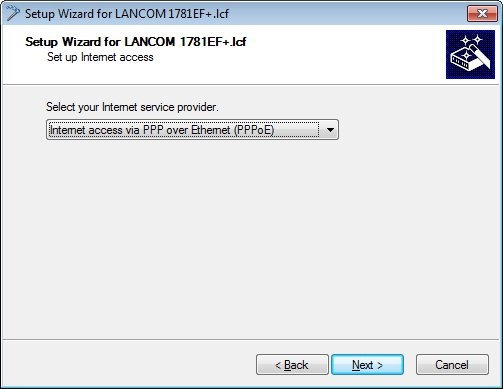
7. Enter a name for your Internet connection. In the interests of clarity we use the name
INTERNET1 for this example.

8. Enter your
login data in the following dialog.

9. Select the corresponding time model.
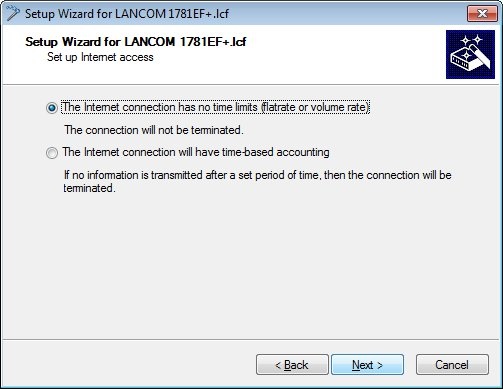
10. You can apply the following default settings without modification. If you wish to use a different time for the daily forced disconnection, change the values in the appropriate fields.
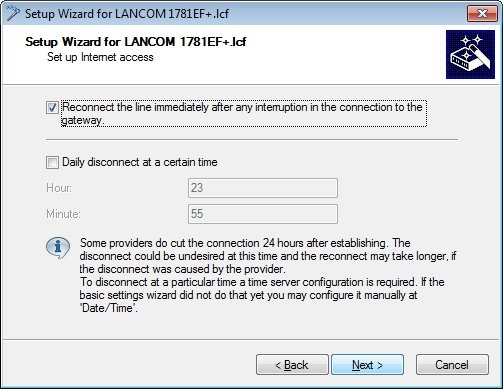
11. In this example,
no backup connection is used, so we will retain the default settings.
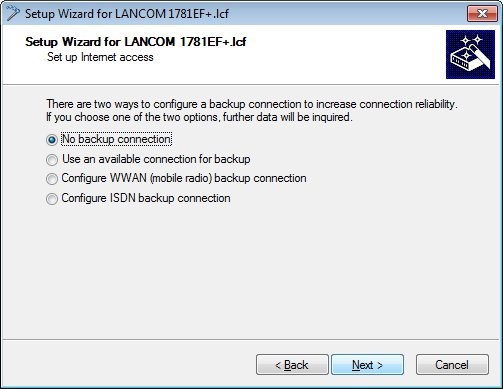
12. Exit the setup Internet connection wizard with the
Finish button. The configured values are then written to the LANCOM router.
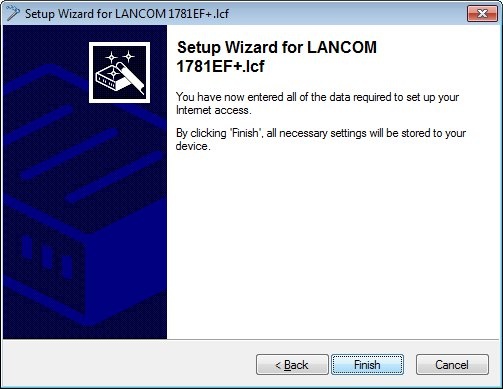
13. After the configuration is written to the device, the setup wizard asks whether you want to continue one with
another wizard.
At this point confirm this with
yes, because another DSL connection has to be set up.
Setting up the second Internet connection: 1. Select the option
Set up Internet access again.
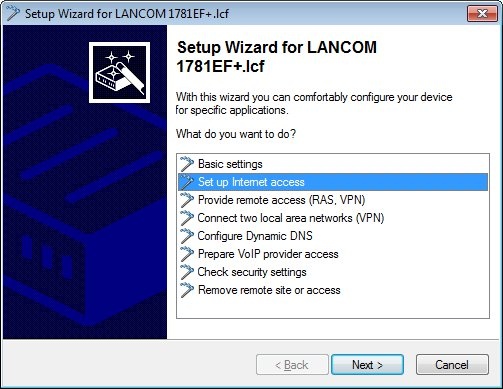
2. In this example we use the
IPv4 internet protocol.
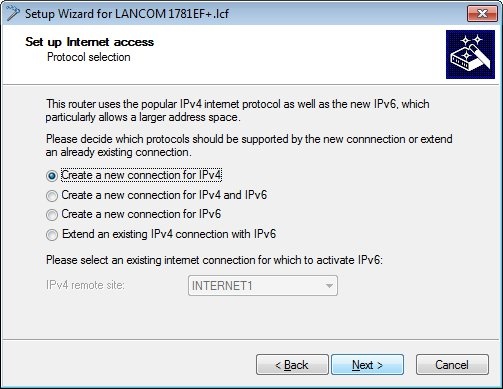
3. Specify that the connection is to be established via the
Ethernet interface.

4. As the second external DSL modem is connected to the LAN1 port of the LANCOM router, the
LAN1 Ethernet port must be selected in the following dialog.
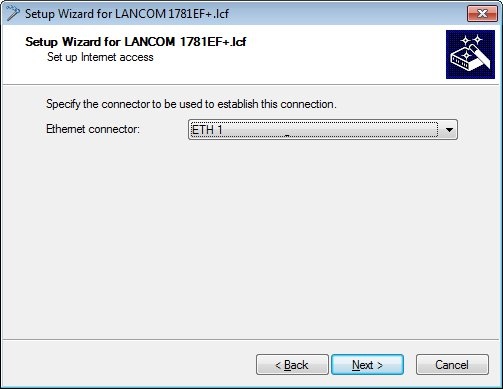
5. Select your
country.
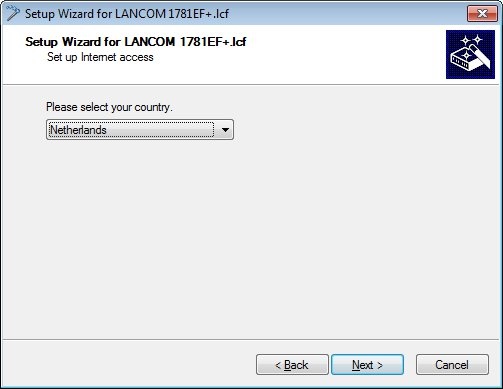
6. Select the option
Internet access via PPP over Ethernet.
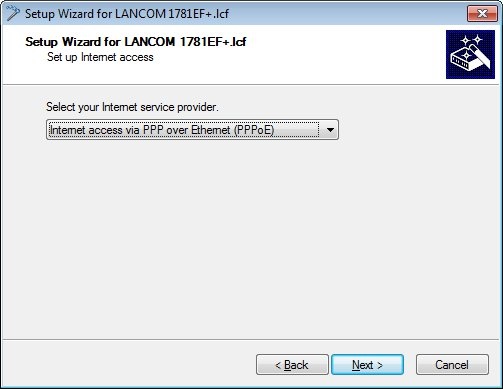
7. Enter a name for your Internet connection. At this point it is important to give this Internet connection a different name than the first one (
INTERNET1). In the interests of clarity we use the name
INTERNET2 for this example.
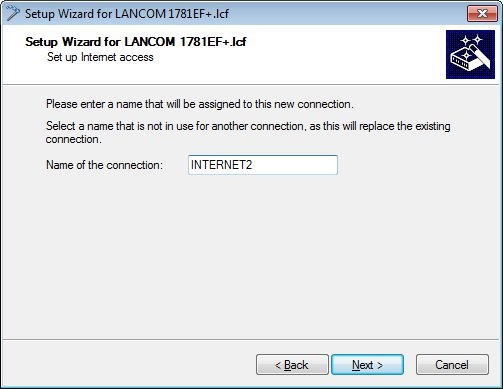
8. Enter your
login data in the following dialog.
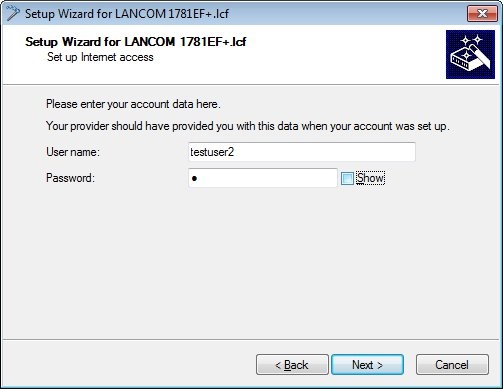
9. Select the corresponding time model:
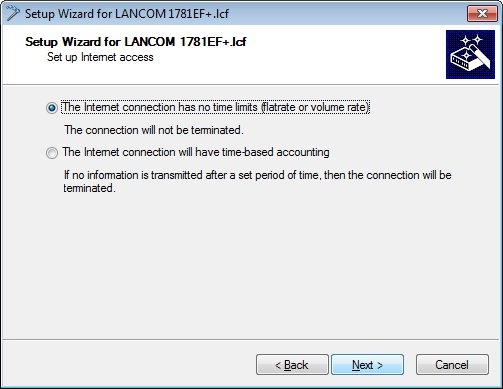
10. You can apply the following default settings without modification. If you wish to use a different time for the daily forced disconnection, change the values in the appropriate fields.
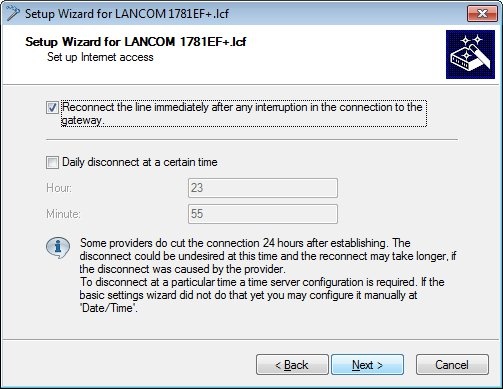
11. In this example,
no backup connection is used, so we will retain the default settings.
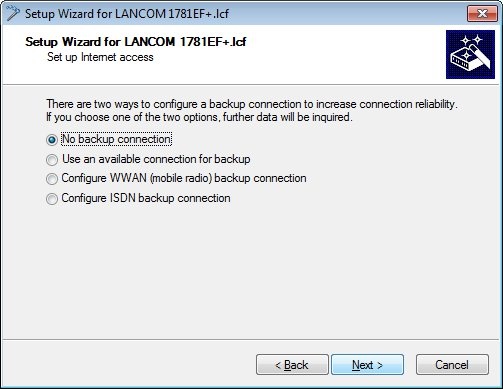
12. A warning appears at this point because the previously established Internet connection
INTERNET1 is configured as the default route.
For now, select the option
leave the current default route. Later in the configuration, we will replace the DSL remote site of the default route with a load-balancing remote.
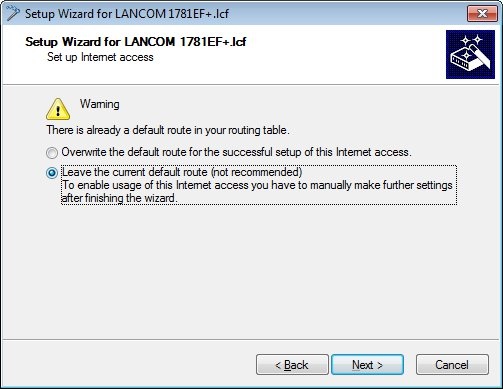
13. Exit the setup Internet connection wizard with the
Finish button. The configured values are then written to the LANCOM router.
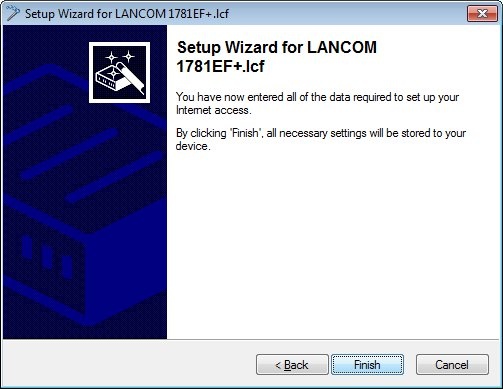
14. After the configuration is written to the device, the setup wizard asks whether you want to continue one with
another wizard. Select
No at this point, because the setup wizard is not required for the remaining steps in the configuration.
Manual configuration steps: For the remainder of the configuration we have to continue in the configuration dialog for the LANCOM router.
1. Select the
DSL-1 interface from the
interface settings:
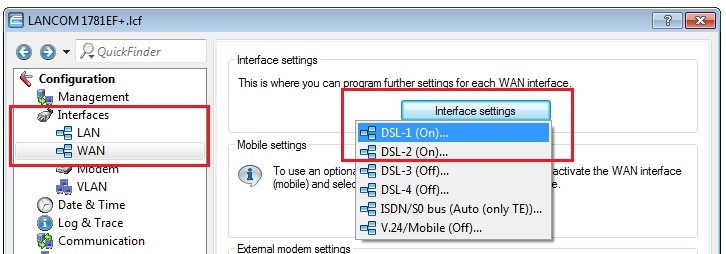
2. In the fields downstream and upstream rate, enter the data transfer rates for the DSL line.
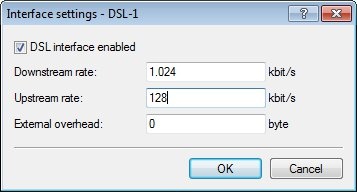
3. Select the
DSL-2 interface from the
interface settings and enter the data for downstream and upstream rate.
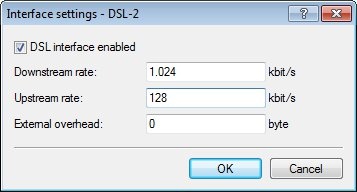 Configuring load balancing:
Configuring load balancing: 1. In order to configure the load balancing, switch to the menu item
IP Router -> Routing -> Load balancing.
2. Next, activate
load balancing.
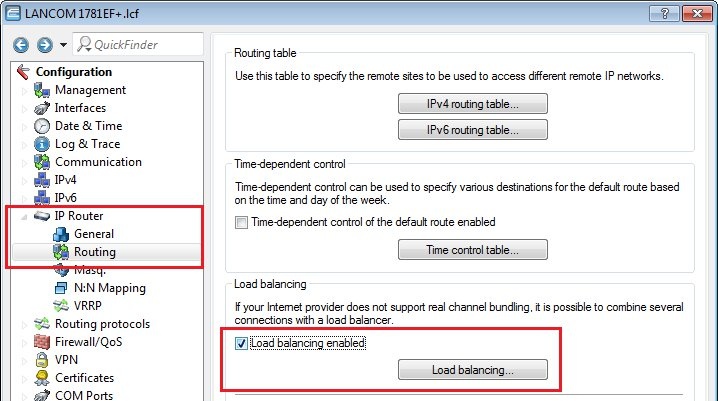
3. Then open the
load-balancing table and define a virtual remote site named
LOADBALANCER. You can use any name of your choice. When using a loadbalancer it is recommended to activate the Client binding function (available as of LCOS 9.10, also see

).
4. Assign the two DSL remote sites
INTERNET1 and
INTERNET2 to the virtual remote site
LOADBALANCER.

5. Accept your entries with
OK.
6. Exit the load balancing table and open the
IPv4 routing table.
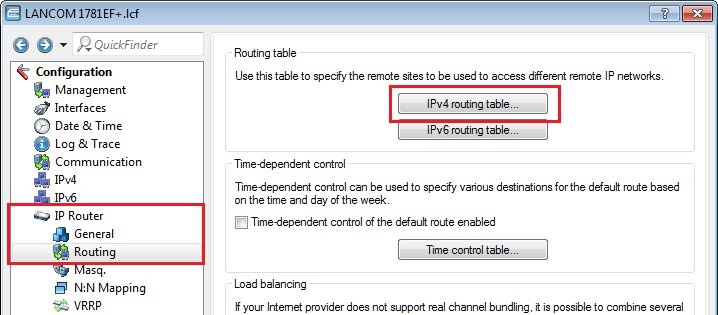
7. Open the routing entry for the default route with a double click.

8. Assign the load balancing device to the default route
LOADBALANCER. Click on
OK.
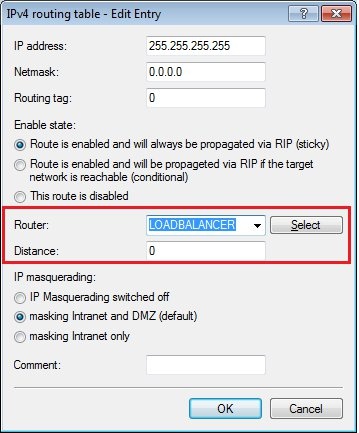
9. The routing table should then appear as follows:

10. Close the routing table and write the configuration back to the LANCOM router.
11. After writing the configuration to the device, the two Internet connections are established. This concludes the configuration.
Function check: Proceed as follows to verify that everything is functioning as expected:
1. Start a SSH session on your LANCOM router (e.g. Putty).
2. Using the command line interface, enter the command
trace # load and press Enter.
3. The trace output should appear as in the figure below.
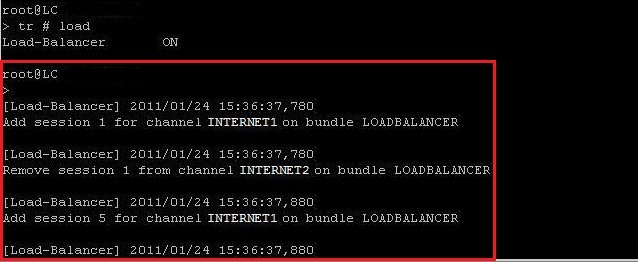
4. Stop the trace by entering the command
trace # load again. Alternatively you can simply close the SSH client.
Information: The load balancing mechanism reacts to the capacity utilization levels (number of sessions) of the Internet connections and distributes packets appropriately between the DSL remote sites.
With load balancing, the two DSL connections are
not bundled.
The load is merely distributed between the connections.